Hilarious newspaper clippings show how people found love before dating apps – from provocative poems to hilarious lonely hearts ads
Finding love in the modern age seems to rely largely on dating apps like Tinder and Bumble.
In fact, today’s young adults—who were born just as online dating was really starting to take over—couldn’t have known any different.
But for hundreds of years, the job of matchmaker largely fell to the ink-and-paper precursor to the Internet: the local newspaper.
In the run-up to Valentine’s Day, hilarious, sad and often poignant clippings reveal how people used to find a romantic match.
Ranging from articles to love poems and columns about lonely hearts, they can be an unlikely source of inspiration when you have someone you want to woo.
Hilarious newspaper clippings show how people found a match before dating through apps, in the form of love poems, columns about lonely hearts and articles
The priceless clippings come from Newspapers.com, an online archive of more than 300 million pages of historical newspapers, managed by genealogy site Ancestry.com.
“The process of finding love is constantly evolving, and our ancient ancestors would have been baffled by today’s world of online communication and dating apps,” says Laura House, family history expert at Ancestry.
“While the medium has changed, there are some elements of the dating game that remain familiar.”
An archival excerpt from a 1936 edition of Birmingham’s Evening Despatch shows that the newspaper reporter even had to act as a matchmaker.
The story, entitled ‘Midland woman seeks husband’, simply reports on a ‘really lonely’ lady aged 38 who is looking for a husband ‘of about 50 or 60’.
In an effort to give herself the best chance of finding her man, she lists her traits as “domesticated,” “affectionate,” and “open-minded.”
The unnamed woman also has a good sense of humor and her own house in a small seaside resort.
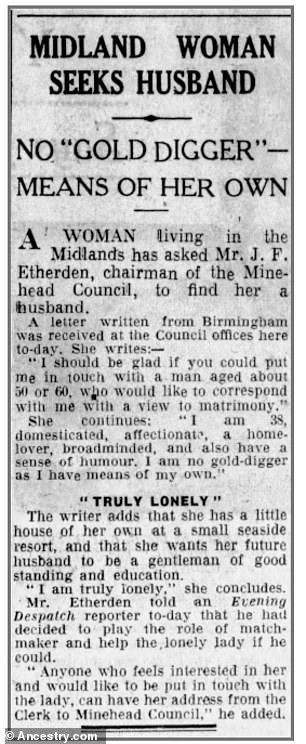
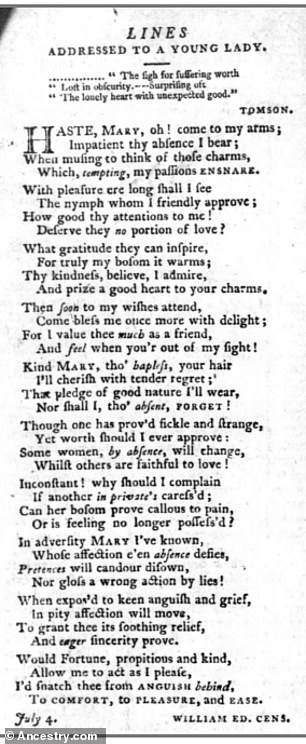
The priceless clippings come from Newspapers.com, an online archive of more than 300 million pages of historical newspapers, managed by genealogy site Ancestry.com
She adds that she is “not a gold digger” – meaning she doesn’t need a man of great wealth – because she has “resources of her own.”
However, she does want a gentleman with “a good reputation and education.”
At the end of the article, male readers are urged to get in touch to register their interest.
Nearly a hundred years later, the question of whether or not the article was a success and whether the woman found love may be lost to history.
In a much earlier excerpt, from Chester Chronicle and Cheshire and North Wales General Advertiser of 1796, a man named William Ed. Cens addresses the object of his desires, Maria, in a self-made poem.
The lovelorn author writes: ‘HURRY, Mary, oh! come into my arms; I bear your absence impatiently; When I muse to think of those charms, which, seductively, ENSNARE my passions.’
He adds that he values Maria “as much as a friend” and asks her to “bless me with joy once more” – suggesting they may have already met.
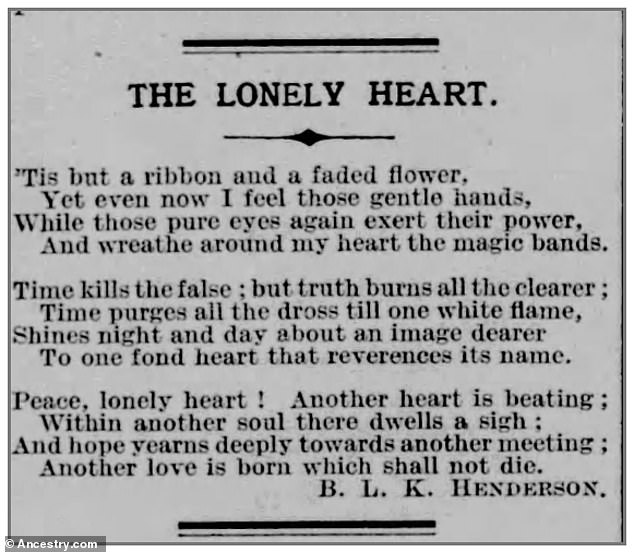
In this 1920 poem, printed in the Hanwell Gazette and Brentford Observer, the author reminisces about ‘those gentle hands’ and ‘pure eyes’
Perhaps hurt by past experiences, William says that “some women will be changed by absence,” while others will be “true to love.”
Another poem, published in the Hanwell Gazette and Brentford Observer in 1920, seems to express the hope of finding another partner.
The author, BLK Henderson, writes: ‘A heart beats again; Within another soul dwells a sigh; And hope deeply longs for a new encounter; Another love is born that will not die.”
Henderson also reminisces about “those gentle hands” and “pure eyes,” suggesting he or she may be struggling to get over a past lover.
Thirty years later, on July 28, 1950, the popular tabloid Reveille reported on an unconventional event aimed at helping singles connect en masse.
An article in the newspaper read: ‘Trains, coaches and planes are being chartered to bring 2,000 lonely hearts from around the world to the small Northumbrian coastal town of Whitley Bay for the most unconventional convention ever held.
‘1000 bachelors and widows and 1000 bachelors and widowers aged between 18 and 80 will arrive in Whitley Bay to spend a meet-and-marry weekend as delegates to a Lonely Hearts Convention.’
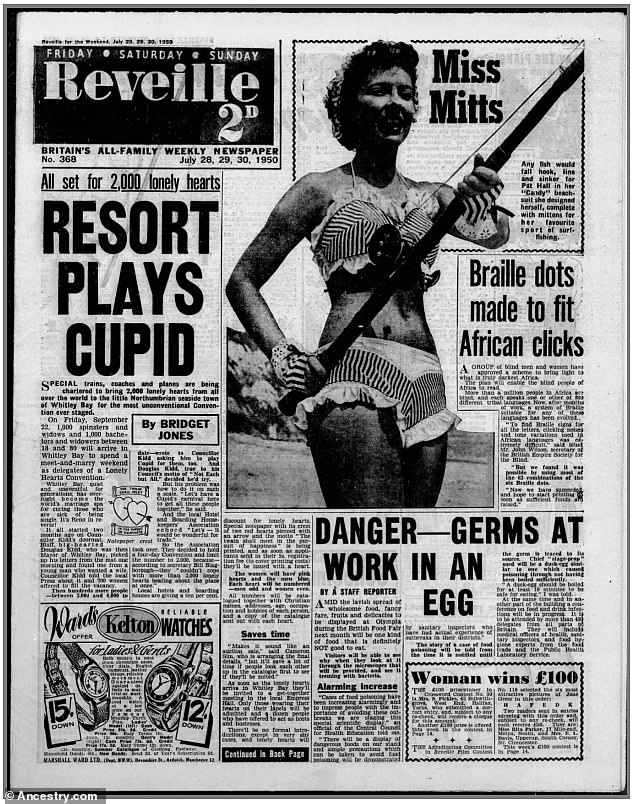
‘Resort plays cupid’: In July 1950, Reveille newspaper reports on the meeting of 2,000 men and women at Whitely Bay for the ultimate match-up event
About 30 years later, finding a match had become a lot easier.
In the 1980s, newspapers ran advertisements for telephone dating, which often involved calling a number and being directed to an operator.
The operator took down some personal information and linked it to another person, although it was a laborious process compared to the ease of today’s apps.
Phone dating largely gave way to online dating in the 1990s, when the Internet became largely accessible from people’s homes.
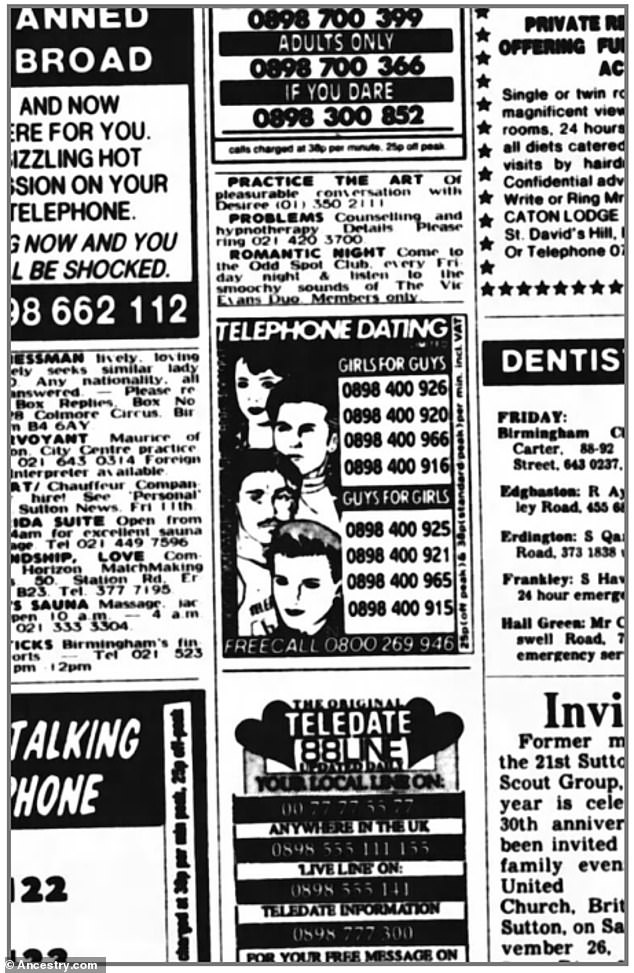
‘Adults only if you dare’: In this 1988 copy of Sandwell Evening Mail, ads give numbers for telephone dating
In general, online dating as we know it dates back to 1995, when Match.com, the first widely recognized online dating website, went live.
Over the next 10 to 15 years, a plethora of other dating sites with unique target groups were set up, including OKCupid (2004), Plenty of Fish (2006), Grindr (2009) and Happn (2013).
One of the most popular, Bumble, launched in 2014, aimed to give women the upper hand by allowing only women to send the first message.
